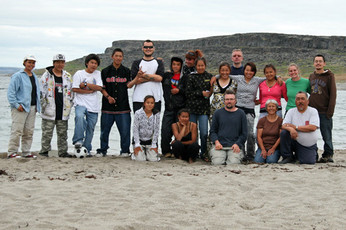IPY in Nunavik second year, Archaeological research in Inukjuak area
By Pierre M. Desrosiers, Archaeologist, Avataq Cultural Institute
This summer Avataq Cultural Institute continued the archaeological research on the Hopewell Islands close to the community of Inukjuak. The team lead by Pierre M. Desrosiers, assisted by Elsa Cencig was composed of Nally Weetaluktuk and Andrew Epoo, also Avataq staff. Local people involved included Simeonie, Alicie and Andy Nalukturuk, Joanie Elijassiapik and Allie Nalukturuk. The field school included 14 secondary school students: Allie Aculiak, Bobby Angnatuk, Moses Idlout, Natalie Echalook, Monica Echalook, Bobby Elijassiapik, Alec Epoo, Pamela Inukpuk, Sarah Iqalluk, Matiusi Kasudluak, Megan Kasudluak, Tonya Moreau, Eva Nowra and Paulo Palliser. Anne-Marie Lemieux (Université Laval student), also involved, is comparing the geomorphological and archaeological data to study the evolution of housing in the region, as well as including traditional knowledge by conducting many interviews with local elders. Najat Bhiry (Université Laval) and Dominique Marguerie (Université de Rennes) were also involved respectively as a geomorpholgist and a wood species and dendrochronology specialist.
The work concentrated mainly on IbGk-3, which is an Inuit winter site as well as a Palaeoeskimo site. Structure 1 (a winter sod house) was still the focus of this excavation, with new square meters opened revealing more of the wood structure first partially uncovered during the 2007 excavation. In some squares it was possible to fully remove the wood (after mapping and sampling them) in order to reach the internal stone features of the structure. Because of the difficulties in excavating this area, main work was done in front of the house where we uncovered part of the midden, composed mainly of animal bones. We had the chance to have many people visit us, including two elders (Lucy Weetaluktuk and Adamie Niviaxie) who spent a day on the site while being interviewed. In order to better understand the procurement strategies for wood and in planning to apply dendrochonology to the wood samples, drift wood was sampled on different islands in order to establish its provenience and its age. Raw stone material sources were also sampled but no new quarries were found.
The second part of the work was to start documenting the IcGn-8 quarry site in collaboration with Adrian Burke (Université de Montréal) who joined us for this 10 day visit. The work included a complete mapping of this huge site where the siltstone outcrop is more than 700 meters long. Piles of waste flake concentrations, which possibly reached up to one meter deep in some areas, are bordering the siltstone outcrop. More than 200 stone hammers where documented in situ.
Finally, besides this work, different islands were visited to do field surveys. This permitted us to record many sites and hundreds of archaeological structures. In this rich area, islands were densely occupied and many years of active research in the region would be necessary to document more accurately the history of human presence since 4000 years ago.

